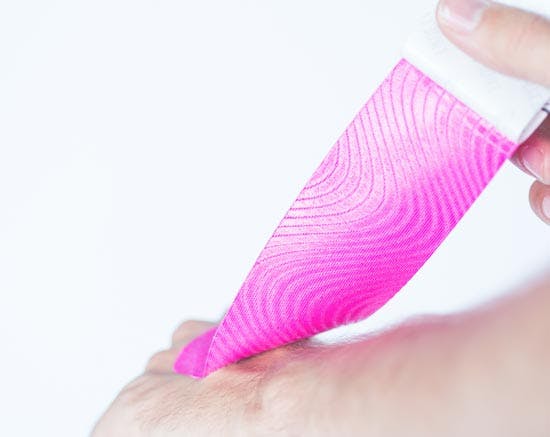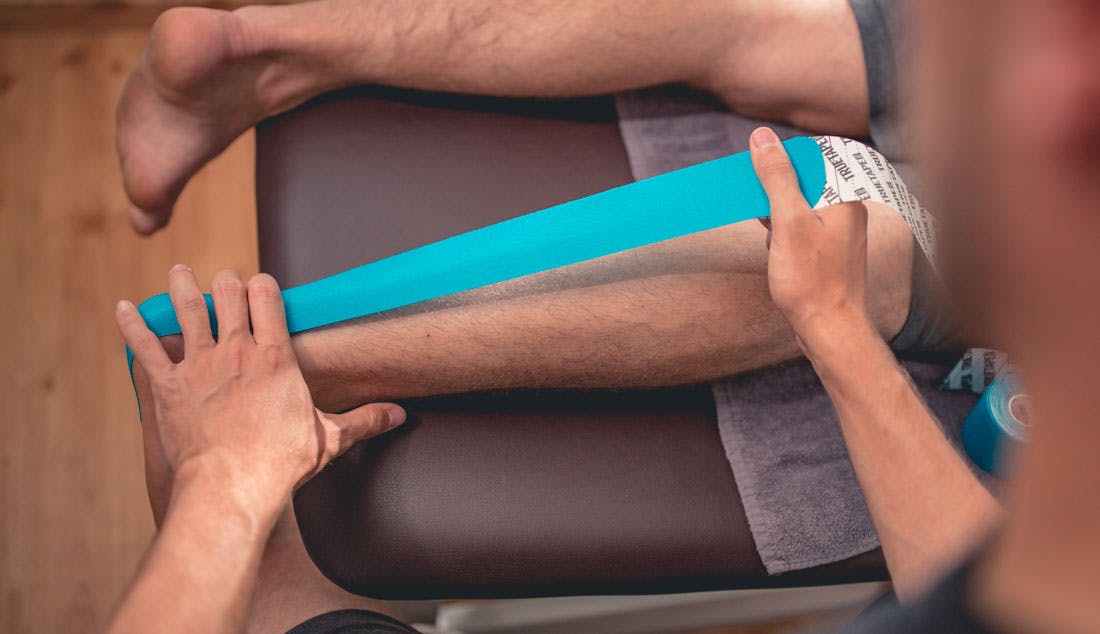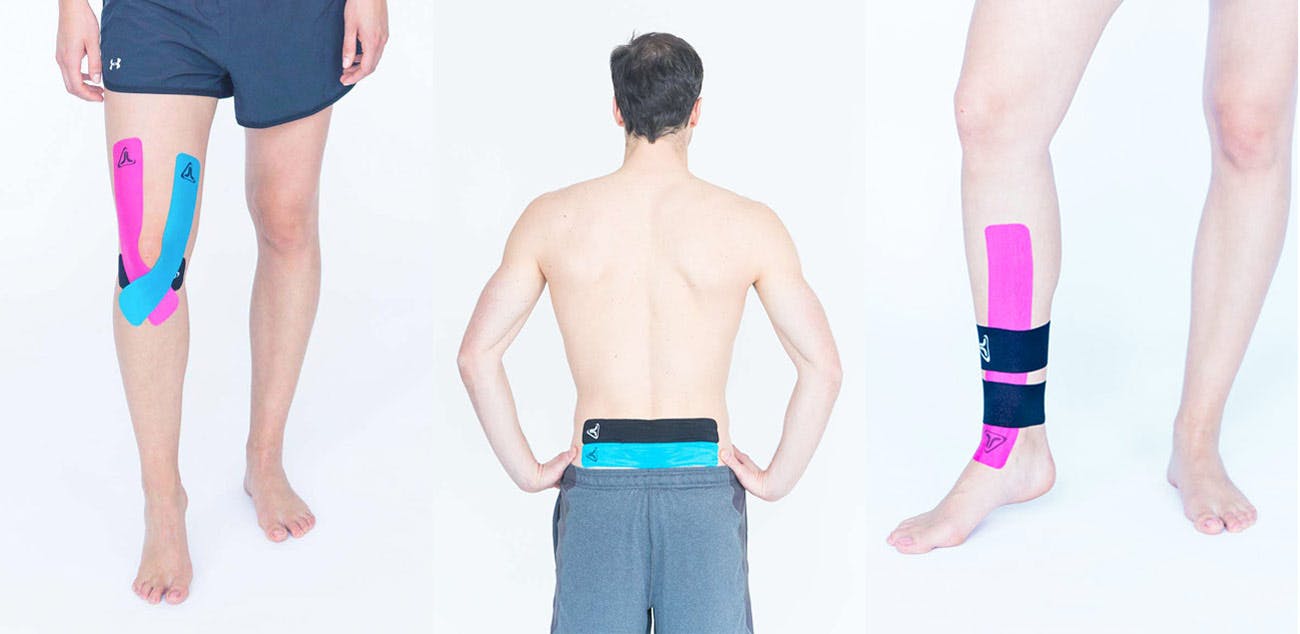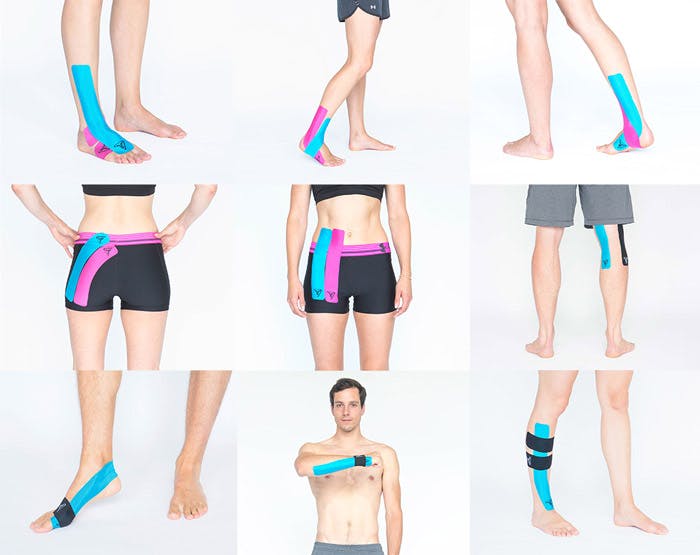An overview of kinesiology tapes.
Everything you need to know about kinesiology tapes and its uses – at a glance.
We use cookies that are necessary for the technical operation of our website and are therefore always active. Other cookies, which are intended to increase the convenience of using this website, serve direct marketing or facilitate the interaction with other websites and social networks, are only activated once you give your consent.
Click here for more information.

Everything you need to know about kinesiology tapes and its uses – at a glance.
On this page, we answer general questions about kinesiology tape, the right way to use kinesiology tapes, their function, and potential areas of use and application.
Kinesiology tape, also known as elastic therapeutic tape or K-Tape is lengthwise elastic adhesive tape consisting of a carrier material made of textile fiber and a layer of acrylic adhesive. The main carrier material is usually cotton. Tapes that have been specifically developed for sports applications, such as TRUETAPE, are specially made with a more elastic and thinner rayon material.

The acrylic adhesive is applied to the tape in a wavy structure. When applying the tape, the lengthwise stretch ensures that the tensile force is also translated into a smaller diagonal force, which means that the tape can lightly move the skin in all directions. Acrylic adhesives are also the standard material for medical products that stick onto the skin, such as Band-Aids and bandages. Our tapes are latex-free with an adhesive that has been tested for great skin tolerance.
Kinesiology tapes can be used on the skin for several days on end, and will stick for between 2 and 7 days, depending on the area of the body and the quality of the tape. Tape is used to treat various problems, and injuries of the musculoskeletal system.*
Kinesiologic tapes offer clear benefits over conventional (sports) tapes, with obvious differences in their form and qualities. As a result, their range of application is also different. Inelastic, rigid tapes such as Leukotape are primarily designed to provide relief to joints and joint areas through mechanical stabilization; kinesiology tapes on the other hand are designed to allow the greatest possible functional movement of the joints. The application of kinesiology tapes is intended to promote functional body movement at an early stage during or after injuries, as clinical studies have shown that this results in faster and better healing.
Rigid, inelastic tapes fix joints in a certain position, which might restrict circulation and blood flow in the treated part of the body. These tapes cause a relatively rapid decrease of muscle mass in the affected joint, which means that they aren’t intended for regular use. When fixing a joint in a certain position, it can be observed that the muscle mass, and therefore the optimal future function of the joint, decreases with time. After immobilization of the joint, this muscle mass must be built up again.
Some further benefits of kinesiology tapes are, extended durability, a very pleasant wearing experience without restrictions to movement, and harmless self-application. Thanks to the tape’s elasticity, it is highly unlikely that applying the tape “wrongly” leads to lasting injury to vessels, nerves, ligaments, tendons, or muscles. The application of rigid and inelastic tapes presents greater risks. If the tape is applied too firmly, this might restrict blood circulation or result in nerve irritation.
The various kinesiology tapes primarily differ among each other because of the quality of the components, such as the carrier material, adhesive, coloring agents, elasticity, and the length and width of the tape design. A standard roll of kinesiology tape measures 5 meters in length with a width of 5 centimeters.
Other available widths are 2.5 cm, 3.75 cm, 7.5 cm, and 10 cm. Narrow tapes (width of less than 5 cm) are primarily used to treat smaller joints, such as the finger joints, as well as small muscle groups. Kinesiology tapes with width of 7.5 or 10 cm are both used for application on large muscles of the thigh or back, as well as in veterinary medicine (particularly to treat large animals such as horses).
In addition to rolls sold by the meter, pre-cut tapes are also available. At TRUETAPE, we primarily use pre-cut lengths of 25 cm. Individual strips can be torn off the roll directly, without using any tools.
All tutorials and taping applications have been specially developed for use with our pre-cut strips. You can find our free video and photo tutorials in the Tutorials section.
Other tape designs include the so-called lymph tapes or edema tapes, which consist of several smaller strips with a common base. Lymph tapes resemble a large fan.
Kinesiology tapes come in many different colors. TRUETAPE is currently available in blue, black, green, and beige. The color of the tape does not influence its qualities such as its elasticity, durability, or adhesive properties. At TRUETAPE, we feel that everyone should be able to choose the color they like, with tapes for universal use.
Another important distinctive feature of kinesiology tape lies in its exceptional elastic properties. The greater the elasticity of the tape, the higher the wearing comfort – and therefore, the longer its wear duration. If a kinesiology tape is not elastic enough, the ends of the tape might start to detach significantly more quickly. This reduces the wearing comfort and might lead to a greater experience of restriction during sports or daily activities.
We therefore developed our TRUETAPE with an elasticity (stretch) of 180–200%.

When is kinesiology tape actually used?
Kinesiology tape has a diverse range of use and application, which has continuously been developed over the years. Kinesiology tapes are used for problems/injuries such as*:
Some examples of specific taping indications are:

Clear contraindications for kinesiology taping are:
There are several circumstances to consider while taping, to ensure efficient tape application. It boils down to using the right technology as well as applying the tape on the skin in a manner befitting the underlying problem.
Essentially, a distinction is made between four types of kinesiology tape application:
Depending on the underlying taping procedure, tapes of various tensile strengths and cuts are used. Muscle applications are usually taped at little to no tension, whereas ligament applications are taped with a strong stretch over tendons or ligament structures. For our TRUETAPE applications, we mostly use taping procedures intended for muscles, or a combination of procedures for muscles and ligament structures.
Laypersons and others without excellent training in the human anatomy should always follow professional tutorials to prevent errors and unnecessary taping.
At TRUETAPE, we offer over 40 free taping step-by-step video and photo tutorials for taping, in addition to our first-class products. You can always rely on professional support for the most-common injuries and symptoms. All tutorials and applications were developed by doctors and physiotherapists.

To get the best-possible taping result and apply the tape in a durable manner with great wearing comfort, you should take several other things into consideration.

J Phys Ther Sci. 2016 Jan;28(1):63-6. doi: 10.1589/jpts.28.63. Epub 2016 Jan 30.
Authors: Lee K1, Yi CW2, Lee S3.
Am J Phys Med Rehabil. 2017 Jan;96(1):25-33.
Kaya Mutlu E1, Mustafaoglu R, Birinci T, Razak Ozdincler A.
J Phys Ther Sci. 2015 Feb; 27(2): 457–459.
Published online 2015 Feb 17. doi: 10.1589/jpts.27.457
Yong Sin Lee, MS, PT,1 Sea Hyun Bae, PhD, PT,2 Jin Ah Hwang, MS, PT,1 and Kyung Yoon Kim, PhD, PT3,*
J Phys Ther Sci. 2016 Apr; 28(4): 1074–1079.
Published online 2016 Apr 28. doi: 10.1589/jpts.28.1074
Gülcan Öztürk, MD,1,* Duygu Geler Külcü, MD,2 Nilgün Mesci, MD,2 Ayşe Duygu Şilte, MD,3 and Ece Aydog, MD4
Pages 252-256 | Received 10 Mar 2016, Accepted 06 Jun 2016, Accepted author version posted online: 08 Jun 2016, Published online: 22 Jun 2016
Journal of Physical Therapy Science
Kaynoosh Homayouni, Shima Foruzi & Fereshte Kalhori
Evidence-Based Complementary and Alternative Medicine
Volume 2015, Article ID 410526, 7 pages
Ick Keun Ahn,1 You Lim Kim,1 Young-Hyeon Bae,1,2,3 and Suk Min Lee1
Department of Physical Therapy, Sahmyook University, Seoul 130-742, Republic of Korea
Department of Physical and Rehabilitation Medicine, Samsung Medical Center, Seoul 138-888, Republic of Korea
Department of Physical Therapy, Angelo State University, San Angelo, TX 76904, USA
Clin J Sport Med. 2017 May;27(3):260-265. doi: 10.1097/JSM.0000000000000345. –> Clinical Journal of sports medicine: Official Journal oft he Canadian Acadamy of Sports Medicine.
Chan MC1, Wee JW, Lim MH.
Med Sci Monit. 2016 Apr 18;22:1297-301.
Kaplan Ş1, Alpayci M2, Karaman E3, Çetin O3, Özkan Y4, İlter S2, Şah V5, Şahin HG3.